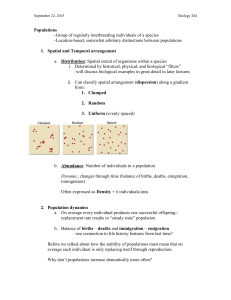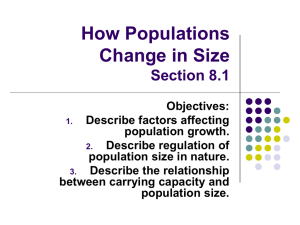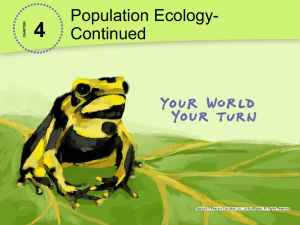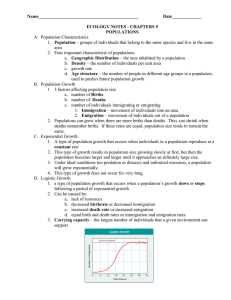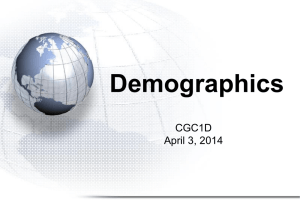apes populations - Sharyland Pioneer High School
advertisement
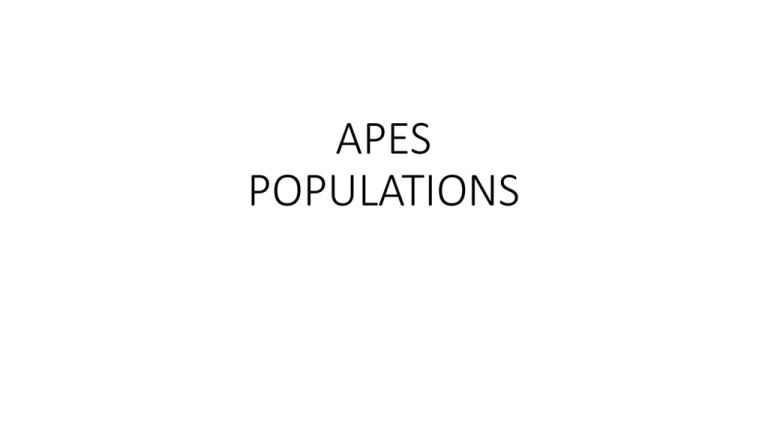
APES POPULATIONS POPULATION ECOLOGY • Studies populations and how these populations interact with the environment • Used to develop conservation • Used to predict the long-term probability of a species * By understanding the way populations grow and what their needs are, scientists and policy makers can better plan for sustainability of resources needed by a population POPULATIONS • A group of organisms of the same species that inhabits a specific geographic area at the same time • Individuals in a population compete for space, light, air, water, food • Living in groups (flocks , schools) has advantages: • 1. increased protection from predators • 2. increased chances for mating • 3. division of labor POPULATION DENSITY Refers to the number of individual of a population that inhabit a specific unit of land or water in the area *(EX) number of squirrels that inhabit a specific forest BIRTHS and DEATHS IMMIGRATION= the # of individuals that enter the population EMIGRATION= the # of individuals that leave the population DENSITY IS A RESULT OF A DYNAMIC INTERPLAY BETWEEN PROCESSES THAT ADD AND REMOVE INDIVIDUALS IN A POPULATION Births and immigration add individuals to a population Deaths and emigration remove individuals from a population LIMITING FACTORS (cause a population to decrease) DENSITY-DEPENDENT *predation *competition for food / space *disease *shelter *build up of toxic materials DENSITY-INDEPENDENT (CATASTROPHIC EVENTS) *FIRE *STORMS *EARTHQUAKES *DROUGHT *VOLCANIC ERUPTION POPULATION DISPERSION *refers to how individual of a population are spaced within a region *3 ways of dispersion CARRYING CAPACITY (K) • Refers to the number of organisms that can be supported in a given area • It is the maximum population size that can sustainably be supported by the available resources in the region • If a population goes over the carrying capacity– death rates become higher than birth rates REGULATING FACTORS OF CARRYING CAPACITY *food/nutrient availability *space *oxygen *sunlight *predation FACTORS THAT AFFECT POPULATION GROWTH INCREASE POPULATION GROWTH DECREASE POPULATION GROWTH *high birth rate *generalized niche *few competitors *good predatory defense *able to migrate *FAVORABLE ENVIRONMENT *low birth rate *specialized niche *many competitors *unsuitable predatory defense *unable to migrate *UNFAVORABLE ENVIRONMENT BIOTIC POTENTIAL *is the amount that a population would grow if there were unlimited resources FACTORS THAT INFLUENCE BIOTIC POTENTIAL 1. age at reproduction 2. frequency of reproduction 3. number of offspring produced 4. life span EXPONENTIAL GROWTH (J- shape curve) • Occurs when resources are unlimited/unrestricted (not realistic) • Forms a J-shaped curve graph • rN = ΔN/Δt (r) = rate of growth (N) = number of individuals (ΔN)= change in number of individuals (Δt) = change in time LOGISTIC GROWTH (S CURVE) *when a population grows rapidly, reaches carrying capacity and stabilizes (realistic model) *the growth rate changes to match the environmental conditions *growth rate stabilizes when the birth rate equals the death rate *growth rate may show fluctuations around the carrying capacity POPULATION CHANGE and GROWTH RATE POPULATION CHANGE = (crude birth rate + immigration) minus (crude death rate + emigration) EX. A population is 20,000 in 1950. (500 + 600) - (140 + 200) = 760 In 1951, the population grew from 20,000 to 20,760 __________________________________________________________________ RATE OF POPULATION CHANGE FORMULA: GROWTH RATE (%) = BIRTH RATE - DEATH RATE ---------------------------------10 EX. 22.2 - 6.4 ------------------- = 1 .6 10 RULE OF 70 *used to predict long term population growth rates *used to estimate population doubling *by dividing 70 by current annual % growth rate of population *(EX) if the growth rate is 5 %, then population will double in 14 years 70/5% = 14 years REPRODUCTIVE STRATEGISTS (2 groups of species based on reproductive strategies) r – strategists *reproduce early in life *mature rapidly/short lived *tend to be prey *low in food web *produce many offspring *low parental care *niche generalists *density-independent regulated *generally small *EXAMPLES: insects, algae, bacteria, rodents, protozoa, weeds K – strategists____________ *reproduce later in life *mature slowly/long lived *both predator and prey *high on food web *produce few offspring *high parental care *niche specialists *density-dependent regulated *generally large *EXAMPLES: elephants, cacti, sharks, lions, humans SURVIVORSHIP CURVES (show age distributions, reproduction, and life history) (is measured by how many organisms are able to mature and reproduce TYPE 1: (LATE LOSS) =reproduction early in life, low mortality rate, high advance age, death during old age (EX) humans, sheep, elephants, annual plants TYPE 2: (CONSTANT LOSS)= all ages uniform death, predation is primary means of death, reach adult stage quickly (EX) birds, rodents, perennial plants TYPE 3: (EARLY LOSS) = have large number of offspring, death in younger members (EX) trees, sea turtles, fish, oysters POPULATION CYCLES 1. BOOM-AND-BUST CYCLE *common with r –strategist *rapid increase in population and then rapid drop off 2. PREDATOR – PREY CYCLE *rainfall low-> less grass for rabbit -> less food for coyote -> Less coyotes *coyote population does not change at exactly the same time as rabbit population HUMAN POPULATION • WORLD POPOULATION AS OF March 2014 estimated at 7,152,717,500 BIRTH RATE (CRUDE BIRTH RATE)= is equal to the # of live births per 1000 members of the population per year DEATH RATE (CRUDE DEATH RATE)= is equal to the # of deaths per 1000 members of the population per year HOW POPULATION CHANGE? *populations can change because of immigration and emigration *most significant addition to population is Births *Total Fertility Rate (TFR) =describes the number of children a woman will bear in her lifetime *Replacement Birth Rate (RBR) = describes the number of children a couple must have in order to replace themselves (must compensate for deaths of children and non-child bearing females) ( can be 2.1 – 2.5) *Fertility is influenced by culture, birth control availability, women’s education REASONS THE WORLD POPULATION HAS INCREASED: (less deaths) *INDUSTRIAL REVOLUTION IMPROVED STANDARD OF LIVING *DEVELOPMENT OF WATER SOURCES *BETTER SANITATION *DEPENDABLE FOOD SUPPLIES *BETTER HEALTH CARE *TECHNOLOGY AGE STRUCTURE DIAGRAMS *graphs that determine birthrate, generation time, death rate, sex ratios *they are indicators of future trends in population growth ZERO POPULATION GROWTH RESULTS FROM : HIGH BIRTH & HIGH DEATH RATES OR LOW BIRTH & LOW DEATH RATES DEMOGRAPHIC TRANSITION MODEL *predicts population trends based on birth rates and death rates *a country’s population will shift from one growth rate type to another *4 DEMOGRAPHIC TRANSITION TYPES 1. PRE-INDUSTRIAL- slow growth, (high birth and high death) difficult living, EX. AFRICA 2. TRANSITIONAL- Fast growth, High birth and less death, better living conditions, EX. MEXICO 3. INDUSTRIAL- slow growth, (low birth and low death), developing country, EX. CHINA 4. POST- INDUSTRIAL- population near or at ZERO POPULATION GROWTH, EX. RUSSIA & UNITED STATES DEMOGRAPHIC TRANSITION TYPES/PHASES IMPACTS OF INCREASED POPULATION GROWTH 1. LAND OVERUSE (for food production) 2. POVERTY 3. HUNGER (insufficient food production and distribution) 4. INCREASE DISEASES 5. POLITICAL INSTABILITY (wars, unemployment, ) 6. PESTILENCE (accumulation of waste) 7. INCREASE POLLUTION 8. GLOBAL WARMING (impact of gases and ozone layer) 9. NATURAL RESOURCE DEPLETION 10. INCREASE ENERGY CONSUMPTION 11. ENVIRONMENTAL DEGRADATION 12. ANIMAL AND PLANT EXTINCTION (due to habitat loss)
